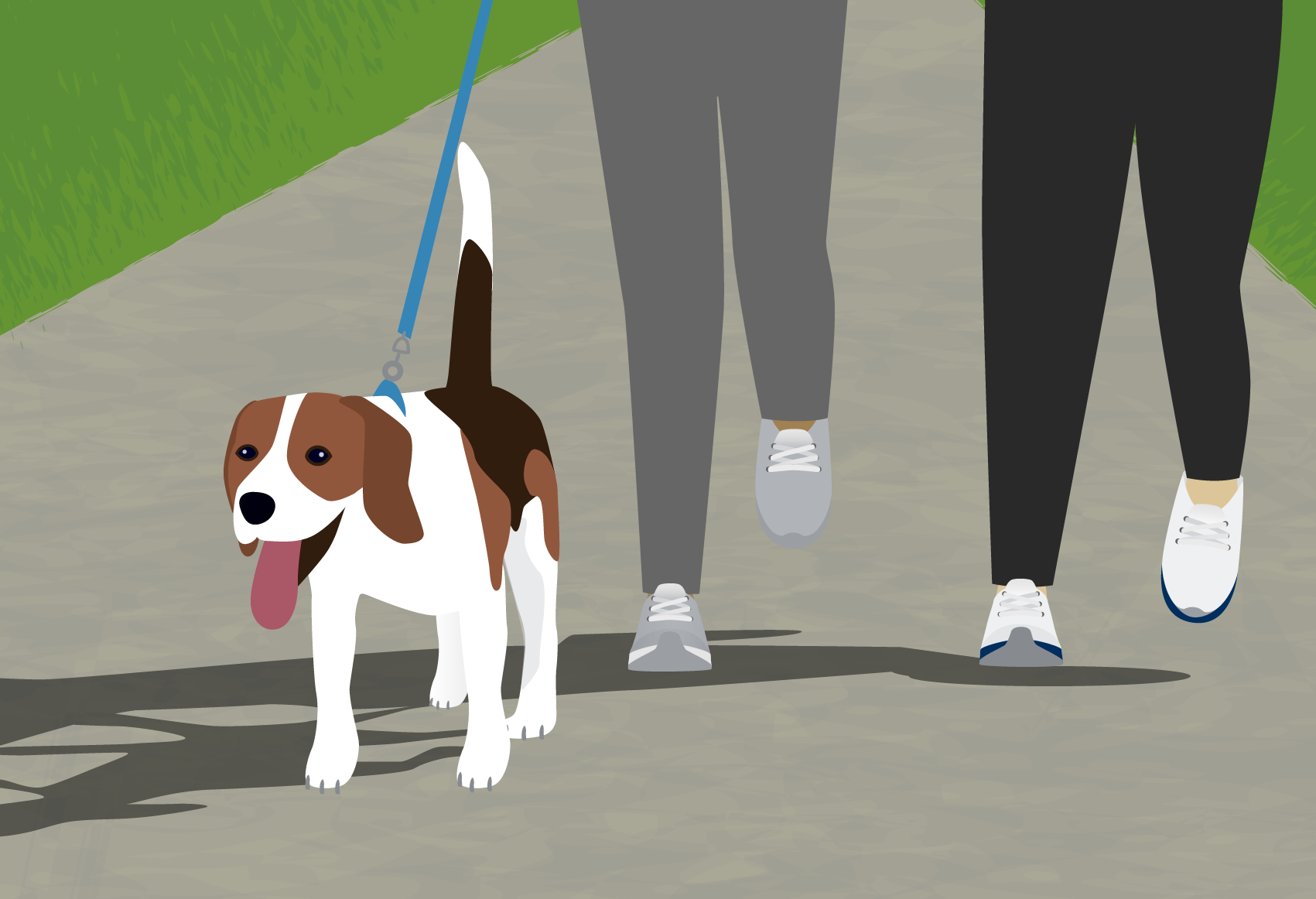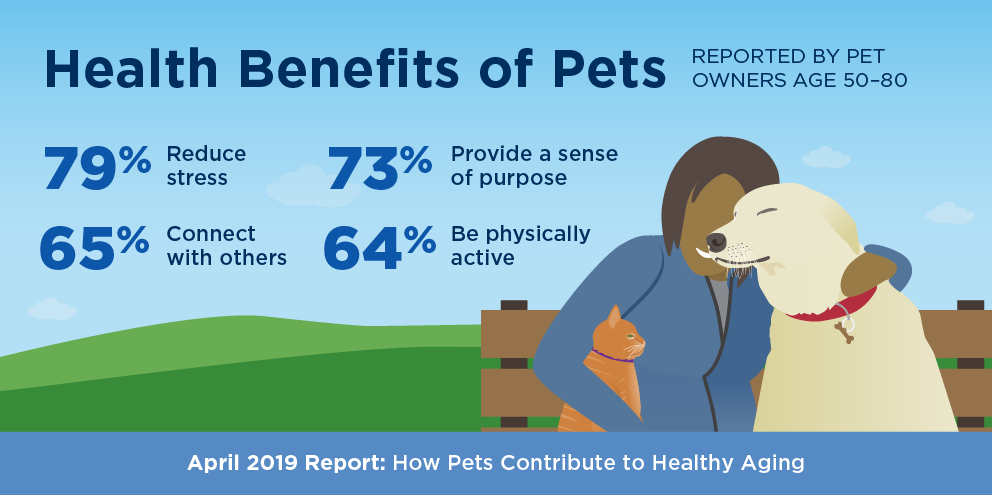
Introduction
Many older Americans live with pets and consider them part of the family. Pets can offer companionship and have a positive impact on a person’s health and well-being. In October 2018, the University of Michigan National Poll on Healthy Aging asked a national sample of adults age 50–80 about their pets, reasons for having — or not having — pets, and the benefits and challenges of owning a pet.
Pets in the Lives of Older Adults
More than half of older adults (55%) reported having a pet. Among pet owners, the majority (68%) had dogs, 48% had cats, and 16% had a small pet such as a bird, fish, or hamster. More than half of pet owners (55%) reported having multiple pets. Adults age 50–64 were more likely than adults age 65–80 to have a pet. While one in five (20%) respondents care for their pet on their own, the majority (80%) reported that others help care for their pets. About half of pet owners (53%) reported that their pets sleep in their bed.
How Pets Can Be Helpful
Pet owners said that their pets help them enjoy life (88%), make them feel loved (86%), reduce stress (79%), provide a sense of purpose (73%), and help them stick to a routine (62%). Respondents also reported that their pets connect them with other people (65%), help them be physically active (64% overall and 78% among dog owners), and help them cope with physical and emotional symptoms (60%), including taking their mind off pain (34%). Among those who lived alone and/or reported fair or poor physical health, 72% said pets help them cope with physical or emotional symptoms. Two in five of those who live alone (43%) and 46% of those in fair or poor physical health reported that their pets help take their mind off pain.

Reasons for Getting (or Not Getting) a Pet
More than half (52%) of pet owners cited companionship as their main reason for getting a pet. One in five (21%) said the main reason was that the pet needed a home.
Common reasons for not having pets included: not wanting to be tied down (42%), cost (23%), and not having time to care for a pet (20%). One in six respondents (16%) cited allergies (either their own or a household member’s) as a reason for not having a pet, while 19% did not have an interest in pets.
Challenges of Pet Ownership
While most pet owners reported positive experiences with their pets, some also noted challenges. More than half (54%) reported that pets make it difficult to travel or enjoy activities away from home, and about one in five (18%) indicated that pet care puts a strain on their budget. One in six (15%) said that their pet’s health takes priority over their own health, and 6% reported that their pets caused them to fall or otherwise injure themselves. Pet owners who lived alone (22%) or reported fair or poor physical health (26%) were more likely to say that their pet’s needs take priority over their own health needs.
Implications
These poll results suggest that pets can provide a myriad of benefits for older adults, including boosts to emotional and physical health. The majority of pet owners believe that their animals connect them to other people, provide companionship, reduce stress, help them be physically active, and cope with physical and emotional symptoms, including pain. They also help them to enjoy life, feel loved, and provide a sense of purpose.
While many respondents reported that their pets positively contribute to their health and well-being, more than one in four pet owners in fair or poor physical health report their pet’s needs take priority over their own health needs. Health care professionals should be aware of the important role that pets play in the lives of many older adults, as pets have the potential to help, or hinder, self-care and adherence to treatment plans.
Of course, pets are not for everyone. Not everyone wants a pet, and others face barriers to having pets, such as the costs of pet care or living in a location where pets are not allowed. For older adults who enjoy the company of pets but cannot have one, volunteering at a local animal shelter, having pet therapy visits, or pet sitting are good ways to engage with animals without the responsibilities of pet ownership.
There are many factors to consider in deciding whether or not to get a pet. A good understanding of the pros and cons can help older adults decide if getting a pet is right for them, or whether to pursue other options for enjoying the company of animals.
Data Source and Methods
This National Poll on Healthy Aging report presents findings from a nationally representative household survey conducted exclusively by Ipsos Public Affairs, LLC (“Ipsos”), for the University of Michigan’s Institute for Healthcare Policy and Innovation. National Poll on Healthy Aging surveys are conducted using the Ipsos KnowledgePanel®, the largest national, probability-based panel in the U.S. Surveys are fielded two to three times a year with a sample of approximately 2,000 KnowledgePanel® members age 50–80.
This survey was administered online in October 2018 to a randomly selected, stratified group of older adults age 50–80 (n=2,051). Respondents were selected from the Ipsos web-enabled KnowledgePanel®, which closely resembles the U.S. population. The sample was subsequently weighted to reflect population figures from the U.S. Census Bureau.
The completion rate was 64% among panel members contacted to participate. The margin of error is ±1 to 3 percentage points for questions asked of the full sample, and higher among subgroups.
Findings from the National Poll on Healthy Aging do not represent the opinions of the University of Michigan. The University of Michigan reserves all rights over this material.
Read other National Poll on Healthy Aging reports and about the poll's Michigan findings, and learn about the poll methodology.
Citation
Janevic M, Solway E, Malani P, Singer D, Kirch M, Kullgren J, Connell, C. How Pets Contribute to Healthy Aging. University of Michigan National Poll on Healthy Aging. April 2019. Available at: http://hdl.handle.net/2027.42/148428
Related article
Special report: One in 10 older adults have gotten a “pandemic pet,” poll finds (2021)